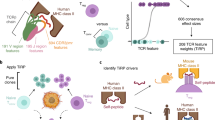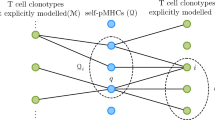Abstract
Cytotoxic and helper T lymphocytes recognize foreign antigen in the form of short peptides associated with class I and class II major histocompatibility complex (MHC) molecules, respectively1–4. A recent study of the three-dimensional structure of a class I MHC molecule revealed a cleft formed by the amino-terminal half of the protein, which could serve as the binding site for these peptides5–6. Because an individual possesses only a limited set of different MHC molecules, each molecule of this set must have the ability to bind a large number of different peptides in order to ensure full immunocompetence. Thus, it can be anticipated that peptides with unrelated sequences compete for binding to the same MHC molecule, and, indeed, this has been shown to occur in vitro7,8. We therefore decided to see whether such competition could also regulate T-cell responses in vivo. We have found that a synthetic peptide corresponding to residues 46–62 of mouse lysozyme, although not immunogenic itself, effectively inhibits the priming for T-cell responses when injected into mice together with foreign protein or peptide antigens. The inhibition observed strictly correlates with the capacity of the competitor to bind to the particular MHC molecule presenting the foreign antigen, and its extent depends on the molar ratio between antigen and competitor.
This is a preview of subscription content, access via your institution
Access options
Subscribe to this journal
Receive 51 print issues and online access
$199.00 per year
only $3.90 per issue
Buy this article
- Purchase on Springer Link
- Instant access to full article PDF
Prices may be subject to local taxes which are calculated during checkout
Similar content being viewed by others
References
Townsend, A. R. M. et al. Cell 44, 959–968 (1986).
Babbitt, B. P., Allen, P. M., Matsueda, G., Haber, E. P. & Unanue, E. R. Nature 317, 359–361 (1985).
Buus, S. et al. Proc. natn. Acad. Sci. U.S.A. 83, 3968–3971 (1986).
Guillet, J-G., Lai, M-Z., Briner, T. J., Smith, J. A. & Gefter, M. L. Nature 324, 260–262 (1986).
Bjorkman, P. J. et al. Nature 329, 506–512 (1987).
Bjorkman, P. J. et al. Nature 329, 512–518 (1987).
Guillet, J-G. et al. Science 235, 865–870 (1987).
Buus, S., Sette, A., Colon, S. M., Miles, C. P. & Grey, H. M. Science 235, 1353–1358 (1987).
Riblet, R. L. in Lysozyme (eds Osserman, E. F., Canfield, R. E. & Beychoke, S.) 89–93 (Academic, New York, London, 1974).
Babbitt, B. P., Matsueda, G., Haber, E., Unanue, E. R. & Allen, P. M. Proc. natn. Acad. Sci. U.S.A. 83, 4509–4513 (1986).
Corradin, G., Etlinger, H. M. & Chiller, J. M. J. Immun. 119, 1048–1053 (1977).
Jones, P. P., Murphy, D. B. & McDevitt, H. O. J. exp. Med. 148, 925–939 (1978).
Adorini, L. et al. Proc. natn. Acad. Sci. U.S.A. (in the press).
Werdelin, O. J. Immun. 129, 1883–1891 (1982).
Rock, K. L. & Benacerraf, B. J. exp. Med. 157, 1618–1634 (1983).
Radovich, J. & Talmage, D. W. Science 158, 512–514 (1967).
Raff, M. C. Nature 298, 791–792 (1982).
Mitchell, A. R., Erickson, B. W., Ryabtsev, M. N., Hodges, R. S. & Merrifield, R. B. J. Am. chem. Soc. 98, 7357–7362 (1976).
Clark-Lewis, I., Aebersold, R., Ziltener, H., Schrader, J. W., Hood, L. E. & Kent, S. B. H. Science 231, 134–139 (1986).
Tam, J. P., Heath, W. F. & Merrifield, R. B. J. Am. chem. Soc. 105, 6442–6455 (1983).
Author information
Authors and Affiliations
Rights and permissions
About this article
Cite this article
Adorini, L., Muller, S., Cardinaux, F. et al. In vivo competition between self peptides and foreign antigens in T-cell activation. Nature 334, 623–625 (1988). https://doi.org/10.1038/334623a0
Received:
Accepted:
Issue Date:
DOI: https://doi.org/10.1038/334623a0
This article is cited by
-
Estimating design space available for polyepitopes through consideration of major histocompatibility complex binding motifs
Biomedical Microdevices (2010)
-
Understanding the focused CD4 T cell response to antigen and pathogenic organisms
Immunologic Research (2009)
-
Peptidomimetic compounds that inhibit antigen presentation by autoimmune disease-associated class II major histocompatibility molecules
Nature Biotechnology (1999)
-
Prevention of acute autoimmune encephalomyelitis and abrogation of relapses in murine models of multiple sclerosis by the protease inhibitor D-penicillamine
Inflammation Research (1995)
Comments
By submitting a comment you agree to abide by our Terms and Community Guidelines. If you find something abusive or that does not comply with our terms or guidelines please flag it as inappropriate.



